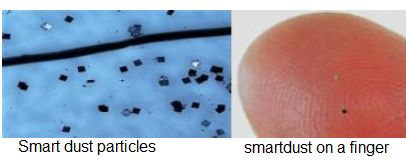Throughout the next few posts, I will shift away from my grandfather’s anomaly and its applications to ASCII toward a research project that I have just initiated in conjunction with my honors electrical engineering advisor, Dr. Julio Urbina. As you shall notice, this project will be one of significant mathematical rigor and quite a challenge for someone not even halfway through the foundational electrical engineering course, EE 210. However, I decided to take on the project (partly through my research seminar course EE 396) to explore a potentially groundbreaking application of my major (EE) and my lifelong passion (mathematics).
What is Smart Dust?
Smart Dust is the collective name given to microscopic drones that function as both satellites and computers, with the ability to communicate with each other to autonomously accomplish a certain task. In a group, the drones resemble a levitating pile of dust (hence the name), and each device may also act as a single spacecraft. Through programming, one is able to synchronize the drones to move, orient themselves, and utilize their sensors in a desired manner. The technology is not widely recognized—only familiarized by me this semester—and research has not been extensive as in other EE applications such as quantum computing, radar, electronic circuit design, etc.

Image Courtesy of Medium
At this stage, I have only amassed research and review papers on the topic and have yet to actually read them in detail. Thus, my decision to shift the focus of this blog (while still emphasizing the purely mathematical aspect) was motivated primarily by my desire to engage with the topic every time I have a chance. While my writing may simply comprise a regurgitation of what I have learned (in terms of the mathematical nature of Smart Dust), I shall treat it as an opportunity to teach a broader audience from my experience, and after all, “to teach is to learn twice.”
Mathematical Aspects?
To convey the nature of the beast that awaits me, I have taken excerpts of equations from a Smart Dust review paper (“A review of Smart Dust architecture, dynamics, and mission applications” by Niccolai, et al.) that I plan to read and analyze from now until Spring Break.
From a mere glance, I recognize an application of linear algebra and vector calculus, covered in courses in which I am currently enrolled (MATH 220 and 230H, respectively). However, applying theoretical-based knowledge of the concepts and operations (resultant from the lack of application in homework problems and exam practice) to a technology of which I know very little will be daunting. Despite this, it is my hope that my passion for mathematics combined with my pursuit of an all-important application of mathematics (EE) will facilitate my learning of and eventual experimentation with (per Dr. Urbina’s request) a device (rather, many devices) that will potentially become ubiquitous yet is currently unheard of among the general public.




